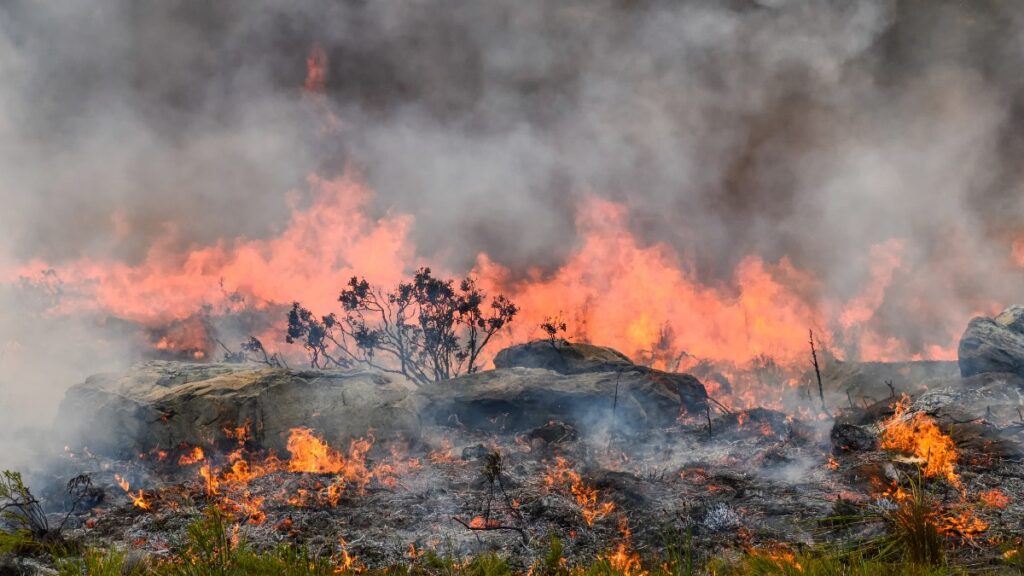Wildfire New Jersey Fully Contained After Scorching Over 2,300 Acres in Wharton State Forest

The wildfire that burned more than 2,300 acres in New Jersey’s Wharton State Forest has now been completely contained. After two days of steady work, fire crews managed to stop the fire. At the same time, wildfires in North and South Carolina are growing fast, burning more than 6,000 acres and forcing many families to leave their homes.
The fire in New Jersey was first spotted around 1:30 p.m. on Saturday, March 22, from a fire tower near Raritan Avenue. However, fire officials believe the fire started earlier, possibly before sunrise.
The wildfire, called the California Branch Fire, quickly spread through Wharton State Forest, covering parts of Burlington and Camden counties. Dry conditions and strong winds helped the fire move fast.
By Sunday evening, the fire had grown to 2,336 acres. Two campgrounds—Atsion and Goshen Pond—were evacuated as a safety measure. Several roads, including Raritan Avenue, Old Atsion Road, 5 Mile Crossing, and the access to Goshen Pond, were closed during the height of the blaze. Eighteen homes were at risk, but none were damaged. The fire was moving away from them.
By Sunday at 6 p.m., fire crews had made substantial progress, managing to contain 80% of the fire. Just a day later, on Monday morning, the New Jersey Forest Fire Service confirmed that the fire was 100% contained.
Still, crews remained on the scene to monitor for flare-ups. Smoke was expected to linger over the burn area for several days, and visitors were cautioned to be alert, as trees weakened by the fire could fall without warning.
This fire was the fourth major wildfire in New Jersey this year. The state is having a dry fire season. After a dry fall and the third-driest January ever recorded, the land is more likely to catch fire.
As of March 13, the New Jersey Forest Fire Service had already responded to 381 wildfires since January. These fires burned 1,242 acres, which is a 266% increase from the same time last year.
While New Jersey can temporarily breathe a sigh of relief, things are getting far more intense farther south, especially in the rugged, forested terrain of the Carolinas. In North Carolina, wildfires are actively burning across Polk County in the western part of the state, about 80 miles west of Charlotte.
The Black Cove Fire, sparked by a downed power line, was pushing eastward toward Henderson County. Mandatory evacuations were issued for about 165 properties, and local officials said visibility and road access in the area had become dangerously limited.
One resident, Kim Callaway, who lives near one of the evacuation zones, prepared her home in case firefighters needed access. Like many others, she had already evacuated her valuables but remained behind to help protect her property.
The fires forced families out of their homes and created a persistent challenge for emergency responders, as fallen pine trees and other debris—much of it left behind by Hurricane Helene last September—now serve as dangerous fuel.
The hurricane brought down millions of trees across the region, leaving behind a huge amount of dead timber. Now, with flash droughts sweeping through the region, all that fallen wood has dried out, becoming highly flammable. North Carolina State University professor Robert Scheller pointed out that dry pine needles and trunks ignite easily and even hinder firefighters by blocking access roads.
The Deep Woods Fire, located five miles northwest of Columbus, was mapped at 2,545 acres by Sunday night. On private land near Lake Adger, the Fish Hook Fire was the smallest of the three, estimated at just under 199 acres, but still significant. By Sunday evening, some evacuation orders related to the Fish Hook Fire were lifted, though crews remained on high alert.
In total, 249 personnel from North Carolina and other states were deployed to fight the wildfires. According to state officials, four homes had already been destroyed, and a Code Red air quality alert had been issued for the area. That means air conditions could be harmful even for healthy individuals, especially those spending extended time outdoors.
To the south, South Carolina is also battling growing wildfires. The state’s governor, Henry McMaster, declared a state of emergency over the weekend as two major fires spread across Pickens and Greenville counties.
One blaze, the Table Rock Fire, ignited on Friday in Table Rock State Park and expanded to more than 1,300 acres by Sunday night. Firefighters intentionally burned several hundred acres around it to try and stop the flames from advancing. The second fire, called the Persimmon Ridge Fire, erupted on Saturday and spread to over 800 acres in Greenville County, South Carolina’s most populous county.
Just like in North Carolina, both of South Carolina’s fires were caused by human activity. No injuries have been reported so far, but about 100 homes are under voluntary evacuation, and state officials have issued a ban on all outdoor burning.
With winds intensifying and mountainous terrain making containment efforts extremely difficult, the fires have continued to spread. At least six aircraft, including a Chinook helicopter and two Black Hawks from the South Carolina National Guard, have been used to drop water on the flames. The Forestry Commission also deployed two Fire Boss planes and several ground crews to clear firebreaks and burn control lines.
Drone and helicopter footage from the South Carolina National Guard showed heavy smoke rising from the hills as flames advanced through wooded slopes still littered with downed timber from Hurricane Helene. According to the Associated Press, that storm damaged over 5,000 miles of state-maintained roads and 7,000 private roads, bridges, and culverts in North Carolina alone—leaving behind a chaotic and combustible environment.
Though a cold front moving east from Texas brought some light rainfall and increased humidity early Monday morning, the relief was brief and not nearly enough to extinguish the fires. Forecasts show dry, warmer weather returning for the rest of the week, raising fears of more outbreaks if people don’t strictly follow burn bans and fire safety measures.









